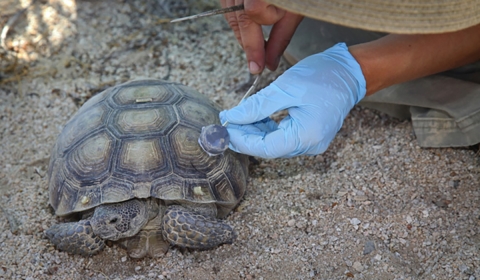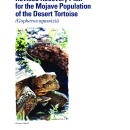What We Do
The Desert Tortoise Recovery Office coordinates the recovery program with other Fish and Wildlife Service offices within the range of the Mojave desert tortoise to:
- Provide effective and coordinated recovery, research, and monitoring activities;
- Provide a sound and defensible scientific basis for decision-making;
- Assess the short- and long-term benefits of recovery actions;
- Provide information and syntheses in a timely manner and useful format;
- Facilitate communication of progress toward, and maintain an open dialogue regarding, desert tortoise recovery goals; and
Provide greater credibility and support for recovery efforts.
Management and Conservation
What does recovery mean related to threatened or endangered species? When a person is injured or has surgery, they often consult with doctors or other experts to develop a plan that will return them to full health and keep them from getting injured again. The U.S. Fish and Wildlife (Service) uses the word "recovery" in a similar way. A "recovery plan" determines the "threats" that are hurting the species, suggests actions that will reduce or eliminate these threats so species can fully recover, and recommends ways to ensure that the population remains stable.
The 2011 Revised Recovery Plan takes a new approach to reversing declines in Mojave desert tortoise populations through a coordinated effort of science-based implementation and evaluation of conservation actions. This revised recovery strategy is a reflection of years of hard work by multiple stakeholders and recognizes the need to modify recovery efforts of the desert tortoise to accommodate changing management needs. The ability to conserve the Mojave desert tortoise and lead to eventual recovery of this threatened species depends on science and innovation. The revised plan recognizes the need to adjust to the accelerating pace of environmental change and its impact on key resource management issues, such as corridors and connectivity. The plan will be a living document that advances a natural resource management model where ongoing detection of changes and attribution of causes will provide the basic information on whether or not the desert tortoise or its ecosystem is changing beyond natural variability.
Key, strategic elements of the revised plan include the following:
- Develop, support, and build partnerships to facilitate recovery;
- Protect existing populations and habitat, instituting habitat restoration where necessary;
- Augment depleted populations in a strategic, experimental manner;
- Monitor progress toward recovery, including population trend and effectiveness monitoring;
- Conduct applied research and modeling in support of recovery efforts within a strategic framework; and
- Implement a formal adaptive management program that integrates new information and utilizes conceptual models that link management actions to predicted responses by Mojave desert tortoise populations or their habitat.
Mojave Desert tortoise captive care guidance
Captive care guidance was developed to promote the survival of wild Mojave desert tortoises temporarily placed in captive environments, a captive husbandry complex, research enclosures, or holding pens. This guidance provides a detailed overview of animal husbandry and the related husbandry plan for all projects anticipating the placement of tortoises in captivity.


